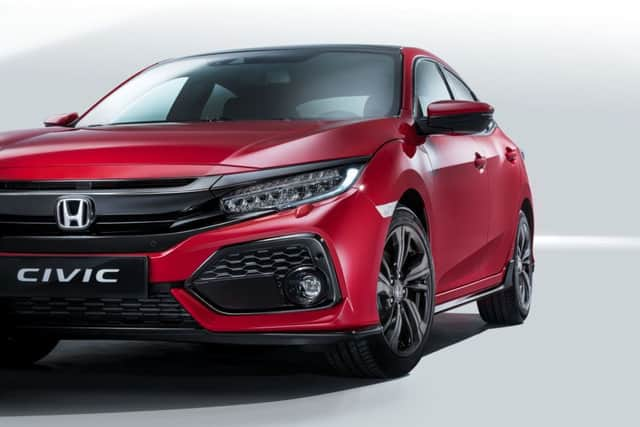Review: Honda Civic


A blaring horn from a Nissan Qashqai warned me I had moved into its lane without a proper check. If “my” Honda’s blind side alert lit up I didn’t notice. Mark that down to carelessness, but if the sat nav had spoken the name of the road I was to take it would have helped me find it. A sequence of “keep left then turn right” (I paraphrase) is not always enough when the options are more than two roads.
The Garmin navigation screen on the Honda did have the written route directions but there was no way I could read them and still drive safely. Some systems say the road names, signpost destinations and so on. What I would need to do is connect Google maps through Android Auto or Apple CarPlay to hear the road names from the Honda.
Advertisement
Hide AdAdvertisement
Hide AdBy coincidence, another Honda driver on the route had trouble with a Qashqai – Sunderland’s finest is common in those parts. We were in the all-new Civic, made with pride in Wiltshire and regarded as the biggest single model global project in Honda’s history.
Honda confirms that it has a “long–term commitment” to make vehicles in the UK and Europe. The Jazz is no longer made at Swindon and production of the CR-V SUV moves to Japan next year, leaving the factory to concentrate on production of this all-new Civic hatchback.
Honda has invested £200 million to continue making Civics at Swindon. Production will reach 160,000 a year of which 40 per cent will go to the US, another 40 per cent to Europe and the world, and the remaining 32,000 cars will be sold in the UK. This Civic is good. It is built on an all-new platform – lower, longer, wider, lighter, stiffer, more economical, roomier, safer and sportier – familiar targets for any new car. It has a three-cylinder, one-litre turbo petrol engine with 127bhp which is expected to be twice as popular as the more powerful and costly 179bhp 1.5-litre, four-cylinder turbo. Both are available with a redesigned six-speed manual gearbox or a revised CVT automatic which simulates a seven speeder.
There are three trim levels with each engine. Prices start at £18,335 for the one-litre SE with manual gears and close at £27,295 for the 1.5 Prestige CVT. They have glossy black alloys and grilles (a silver face identifies the Prestige) and black panels on the corners which make it look hotter than it is and certainly give it presence. The 1.5 Sport and Sport Plus get twin centre exhausts for some more faux dynamics; again, they make it look hot. However, they take up space so those versions have a shallower luggage boot.
The unusual aerodynamic spoiler which splits the rear window has been made less intrusive and the window is now a single piece of glass. Gone completely from Civic is the “magic seat”, unique to Hondas, which has a base which stacks vertically behind the front seats, leaving a large contained space twixt front seats and the rear seat backrest. This is useful for holding, say, a bike, something heavy, something fragile.
Anyway, the lowered ride height and repositioning of the fuel tank and the introduction of independent rear suspension instead of a torsion beam precluded the fancy seat. Honda research seems to suggest that owners didn’t value it. Nor, it seems, the Tourer estate model – the best-looking Civic – which is not in the plan. What will follow is a very potent Type R hatch. There will also be a 1.6 diesel later in the year to suit long distance types and company men. Some markets can buy saloons made in Canada but these are unlikely to be imported to Britain.
The test route was on a loop inland from Barcelona through the Sierra de Collserola national park and then along the coast to Sitges, using motorway, local and national roads, with plenty of twisty uphill and a reciprocal amount of downhill over a variety of surfaces.
The one-litre engine pulls well, only getting growly, in a sporty note, when hauling uphill. The 1.5 unit is smoother and stronger but pound for pound the one-litre “three” looks the winner and is powerful enough for the typical Civic buyer. However, its macho body may bring in buyers from other sporty hatchbacks (Focus, Leon) and the 1.5 engine may appeal. So too the torquey diesel.
Advertisement
Hide AdAdvertisement
Hide AdCabin design features the large central tachometer with a digital speed reading in its orbit, plus information on the trip and a repeater of the navigation signing, eco technique and so forth. There is plenty of cabin storage, including space behind the floating central console, a sliding cover for the cubby between the seats – more ergonomic than a lift-up flap.
More bright thinking is found in the luggage cover. Instead of a hinged rigid shelf, which is always fiddly to remove, the Civic has a roller blind which runs across the load bay and is even switchable to suit left and right-handed operation.
There’s nothing to put you off if you are in the market for a family hatchback with lashings of style and pedigree. True, most of that black corner cladding is fake honeycomb mesh but as an emotional hook it gives the Civic huge presence. It’s a long way from the original, conservatively styled Civics decades ago. Nice, too, to find the suspension more refined – a signature attribute in other areas you touch and feel.